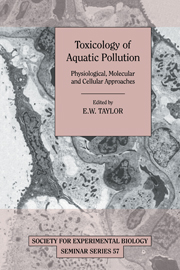Book contents
- Frontmatter
- Contents
- List of contributors
- Preface
- Water chemistry at the gill surfaces of fish and the uptake of xenobiotics
- Bioaccumulation of waterborne 1,2,4,5-tetrachlorobenzene in tissues of rainbow trout
- Dietary exposure to toxic metals in fish
- The physiology and toxicology of zinc in fish
- Lethal and sub-lethal effects of copper upon fish: a role for ammonia toxicity?
- The physiological status of brown trout exposed to aluminium in acidic soft waters
- Physiological and metabolic costs of acclimation to chronic sub-lethal acid and aluminium exposure in rainbow trout
- Physiological effects of nitrite in teleosts and crustaceans
- Metallothioneins in fish: induction and use in environmental monitoring
- Oestrogenic substances in the aquatic environment and their potential impact on animals, particularly fish
- Effect of genetic toxicants in aquatic organisms
- In vitro toxicology of aquatic pollutants: use of cultured fish cells
- Principles governing the use of cytochrome P4501A1 measurement as a pollution monitoring tool in the aquatic environment
- Index
Preface
Published online by Cambridge University Press: 20 May 2010
- Frontmatter
- Contents
- List of contributors
- Preface
- Water chemistry at the gill surfaces of fish and the uptake of xenobiotics
- Bioaccumulation of waterborne 1,2,4,5-tetrachlorobenzene in tissues of rainbow trout
- Dietary exposure to toxic metals in fish
- The physiology and toxicology of zinc in fish
- Lethal and sub-lethal effects of copper upon fish: a role for ammonia toxicity?
- The physiological status of brown trout exposed to aluminium in acidic soft waters
- Physiological and metabolic costs of acclimation to chronic sub-lethal acid and aluminium exposure in rainbow trout
- Physiological effects of nitrite in teleosts and crustaceans
- Metallothioneins in fish: induction and use in environmental monitoring
- Oestrogenic substances in the aquatic environment and their potential impact on animals, particularly fish
- Effect of genetic toxicants in aquatic organisms
- In vitro toxicology of aquatic pollutants: use of cultured fish cells
- Principles governing the use of cytochrome P4501A1 measurement as a pollution monitoring tool in the aquatic environment
- Index
Summary
This book originated from a symposium on Aquatic Toxicology at the Easter meeting of the Society for Experimental Biology at the University of Kent in Canterbury in 1993. It is in some respects a sequel to the volume entitled Acid Toxicity and Aquatic Animals (Seminar Series volume 34), as it is soft, acid waters into which toxic metal ions are leached from rocks and industrial waste. In this previous volume the role of aluminium in determining acid toxicity was discussed, and this account is extended into the current volume and amplified by consideration of the mechanisms of toxicity of other metal species and of the aromatic hydrocarbons, at low to sublethal levels. New approaches to the problem of pollution monitoring are considered, including the construction of large-scale models for the exchange of xenobiotics between fish and their environment, and the alternative use of sensitive cellular and molecular markers of pollution. A contemporary account of this general area is also provided by Aquatic Toxicology: Molecular, Biochemical and Cellular Perspectives edited by Donald C. Malins and Gary K. Ostrander, published by Lewis Publishers, 1994. Fortunately, there is little direct overlap between the two accounts, and the overall approach is differerent so that the volumes complement one another and both provide valuable background for students and practitioners of aquatic toxicology.
- Type
- Chapter
- Information
- Toxicology of Aquatic PollutionPhysiological, Molecular and Cellular Approaches, pp. xi - xviPublisher: Cambridge University PressPrint publication year: 1996
- 1
- Cited by

